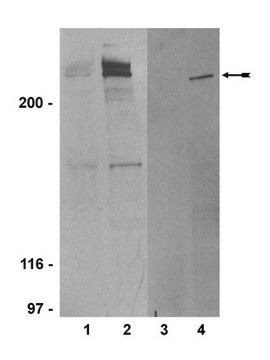07-1286
Anti-ATM Antibody
Upstate®, from rabbit
Synonym(s):
A-T, mutated, AT mutated, ataxia telangiectasia mutated, ataxia telangiectasia mutated (includes complementation groups A, C and D), ataxia telangiectasia mutated protein, ATM, human phosphatidylinositol 3-kinase homolog, serine-protein kinase ATM, TEL1,
About This Item
Recommended Products
biological source
rabbit
Quality Level
antibody form
affinity isolated antibody
antibody product type
primary antibodies
clone
polyclonal
purified by
affinity chromatography
species reactivity
mouse, human
species reactivity (predicted by homology)
horse (based on 100% sequence homology), bovine (based on 100% sequence homology), rat (based on 100% sequence homology)
manufacturer/tradename
Upstate®
technique(s)
immunocytochemistry: suitable
western blot: suitable
isotype
IgG
NCBI accession no.
UniProt accession no.
shipped in
wet ice
target post-translational modification
unmodified
Gene Information
bovine ... Atm(526824)
human ... ATM(472)
mouse ... Atm(11920)
rat ... Atm(300711)
General description
Specificity
Immunogen
Application
Epigenetics & Nuclear Function
Nuclear Receptors
Immunocytochemistry Analysis: A representative lot detected ATM in HeLa and NIH/3T3 cells.
Immunocytochemistry Analysis: 2 µg/mL from a representative lot detected ATM in NIH/3T3 cells.
Quality
Western Blotting Analysis: A 1:500 dilution of this antibody detected ATM in 10 µg of HeLa nuclear extract.
Target description
Physical form
Storage and Stability
Handling Recommendations: Upon receipt, and prior to removing the cap, centrifuge the vial and gently mix the solution.
Analysis Note
HeLa nuclear extract
Other Notes
Legal Information
Disclaimer
Not finding the right product?
Try our Product Selector Tool.
recommended
Storage Class
12 - Non Combustible Liquids
wgk_germany
WGK 1
flash_point_f
Not applicable
flash_point_c
Not applicable
Certificates of Analysis (COA)
Search for Certificates of Analysis (COA) by entering the products Lot/Batch Number. Lot and Batch Numbers can be found on a product’s label following the words ‘Lot’ or ‘Batch’.
Already Own This Product?
Find documentation for the products that you have recently purchased in the Document Library.
Our team of scientists has experience in all areas of research including Life Science, Material Science, Chemical Synthesis, Chromatography, Analytical and many others.
Contact Technical Service








